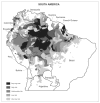Amazonian malaria: asymptomatic human reservoirs, diagnostic challenges, environmentally driven changes in mosquito vector populations, and the mandate for sustainable control strategies
- PMID: 22015425
- PMCID: PMC3308722
- DOI: 10.1016/j.actatropica.2011.10.001
Amazonian malaria: asymptomatic human reservoirs, diagnostic challenges, environmentally driven changes in mosquito vector populations, and the mandate for sustainable control strategies
Abstract
Across the Americas and the Caribbean, nearly 561,000 slide-confirmed malaria infections were reported officially in 2008. The nine Amazonian countries accounted for 89% of these infections; Brazil and Peru alone contributed 56% and 7% of them, respectively. Local populations of the relatively neglected parasite Plasmodium vivax, which currently accounts for 77% of the regional malaria burden, are extremely diverse genetically and geographically structured. At a time when malaria elimination is placed on the public health agenda of several endemic countries, it remains unclear why malaria proved so difficult to control in areas of relatively low levels of transmission such as the Amazon Basin. We hypothesize that asymptomatic parasite carriage and massive environmental changes that affect vector abundance and behavior are major contributors to malaria transmission in epidemiologically diverse areas across the Amazon Basin. Here we review available data supporting this hypothesis and discuss their implications for current and future malaria intervention policies in the region. Given that locally generated scientific evidence is urgently required to support malaria control interventions in Amazonia, we briefly describe the aims of our current field-oriented malaria research in rural villages and gold-mining enclaves in Peru and a recently opened agricultural settlement in Brazil.
Copyright © 2011 Elsevier B.V. All rights reserved.
Figures




References
-
- Akhavan D, Musgrove P, Abrantes A, d’A Gusmão R. Cost-effective malaria control in Brazil. Cost-effectiveness of a Malaria Control Program in the Amazon Basin of Brazil, 1988–1996. Soc Sci Med. 1999;49:1385–1399. - PubMed
-
- Alexander N, Rodriguez M, Perez L, Caicedo JC, Cruz J, Prieto G, Arroyo JA, Cotacio MC, Suarez M, FDLH, Hall AJ. Case-control study of mosquito nets against malaria in the Amazon region of Colombia. Am J Trop Med Hyg. 2005;73:140–148. - PubMed
-
- Alves FP, Durlacher RR, Menezes MJ, Krieger H, Silva LH, Camargo EP. High prevalence of asymptomatic Plasmodium vivax and Plasmodium falciparum infections in native Amazonian populations. Am J Trop Med Hyg. 2002;66:641–648. - PubMed
-
- Alves FP, Gil LH, Marrelli MT, Ribolla PE, Camargo EP, Da Silva LH. Asymptomatic carriers of Plasmodium spp. as infection source for malaria vector mosquitoes in the Brazilian Amazon. J Med Entomol. 2005;42:777–779. - PubMed
Publication types
MeSH terms
Grants and funding
LinkOut - more resources
Full Text Sources
Medical

